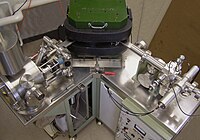
Photo from wikipedia
ABSTRACT In this review, we examine the variation in stable isotope signatures of the lighter elements (δ2H, δ13C, δ15N, δ18O, and δ34S) of tissues and excreta of domesticated animals, the… Click to show full abstract
ABSTRACT In this review, we examine the variation in stable isotope signatures of the lighter elements (δ2H, δ13C, δ15N, δ18O, and δ34S) of tissues and excreta of domesticated animals, the factors affecting the isotopic composition of animal tissues, and whether stable isotopes may be used to differentiate organic and conventional modes of animal husbandry. The main factors affecting the δ13C signatures of livestock are the C3/C4 composition of the diet, the relative digestibility of the diet components, metabolic turnover, tissue and compound specificity, growth rate, and animal age. δ15N signatures of sheep and cattle products have been related mainly to diet signatures, which are quite variable among farms and between years. Although few data exist, a minor influence in δ15N signatures of animal products was attributed to N losses at the farm level, whereas stocking rate showed divergent findings. Correlations between mode of production and δ2H and δ18O have not been established, and only in one case of an animal product was δ34S a satisfactory marker for mode of production. While many data exist on diet–tissue isotopic discrimination values among domesticated animals, there is a paucity of data that allow a direct and statistically verifiable comparison of the differences in the isotopic signatures of organically and conventionally grown animal products. The few comparisons are confined to beef, milk, and egg yolk, with no data for swine or lamb products. δ13C appears to be the most promising isotopic marker to differentiate organic and conventional production systems when maize (C4) is present in the conventional animal diet. However, δ13C may be unsuitable under tropical conditions, where C4 grasses are abundant, and where grass-based husbandry is predominant in both conventional and organic systems. Presently, there is no universal analytical method that can be applied to differentiate organic and conventional animal products.
Journal Title: Critical Reviews in Food Science and Nutrition
Year Published: 2017
Link to full text (if available)
Share on Social Media: Sign Up to like & get
recommendations!